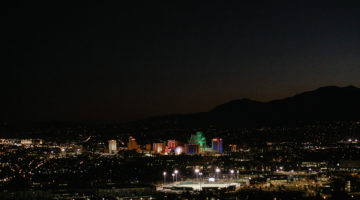The end of August in the Biggest Little City can be marked by the large amount of cars traveling through the city with dusty bicycles hitched to the rear and an obscure art sculpture peeking out of the trunk. Reno is a gateway city through which Burners travel to get to the Playa, but in recent years the Burning Man culture has not left the city as the event passed. Burning Man art and artists have chosen to make Reno their permanent homes.
Reno City Council approved a proposal last week to turn the empty lots of two demolished downtown motels into a temporary art park.
Last year, a group of artists and business owners created the Gateway Project to bring art from Burning Man to Reno. The Gateway Project is a coalition of nonprofits, artists and businesses dedicated to raising funds to bring public sculptures from the Playa to Northern Nevada. The group is leading the project.
The project, called The Playa Art Park will include seven sculptures created by five different Burning Man artists.
“Burning Man is only two hours away from Reno, so since 2008 we have been bringing the art of Burning Man to Reno to share our culture with the city of Reno,” said Maria Partridge, an Artist Advocate for Burning Man. “The idea that burners spend a lot of money in Reno on their way out to the playa has made Reno a gateway city. We felt it was important to continue bringing sculptures from Burning Man to downtown Reno to share our culture.”
Last year, the project brought the sculpture titled, “Pentamonium” by Gary Gunderson to the front of the Lear Theater in downtown Reno. “Pentamonium” was a piece originally at the 2015 Burning Man.
Sculptures built for Burning Man are showcased at the event, but after the event go back to warehouses where they sit and collect dust, said Partridge who decided she wanted to showcase this art in the city to create a community gathering place and connect the Burning Man culture with Reno.
Another way to connect with Burning Man culture, aside from visiting the Playa, is to attend the Burning Man Decompression, an event each year that welcomes Burners and community members to celebrate the end of the Burning Man season. This year’s Reno Decompression consisted of fire dancing, music, an auction and local art cars.
“Burning man is such a touching event that sometimes people get depressed after it is over and the Decompression helps them get back into their community and back into their lives,” said Dale Weber, the Regional Contact for Reno Burning Man and a board member of Reno Burners, LLC.
Cities across the U.S. host decompressions, but what separates the Reno Decompression from others is its role as a fundraiser for Burning Man and the Reno community. According to Weber, the cost of a ticket to the Reno Decompression was $20 this year and 100 percent of the proceeds from ticket sales go back into the community.
The proceeds go toward grants for civic art projects, Burning Man art and a Reno charity. In the past, Decompression has donated to the Boys and Girls club of Reno.
“We have such a vibrant Burner community in Reno, Burning Man is a year-round event here. The Burning Man headquarters in San Francisco are jealous of our community because we have so many projects and groups that are focused on Burning Man and making it a year-round community-based event,” Weber said.
Burning Man draws over 70,000 people each year to Black Rock Desert in Northern Nevada for a celebration of art and culture.
“Burning Man has brought a lot of artists coming through Reno on their way to the event and has given people a chance to see another side of Reno,” Partridge said. “A lot of people are moving here from the Bay Area, a lot of young artists are moving here and opening up artist collectives because it is more economical to live here and to rent work space.”
Last year, the Gateway Project in partnership with ARTECH, a 501(c)(3) art nonprofit, launched a fundraiser to raise $30,000 to support the Playa Art Park before they proposed the idea to the Reno City Council.
The city of Reno will pay an additional $500 toward the insurance policy for liability along with the self-insured liability policy of $1 million to cover the art display.
The Playa Art Park will take over the empty lots left by the demolition of the former Golden West Motor Lodge and the Heart o’ Town Motel. The park will remain on the lot for six to 12 months.
“Instead of being an empty lot, the lot will contain an art park that will be a shining star in our community,” Weber said.
The project will include a mural by Joe C. Rock, a sculpture of two blue steel butterflies titled “Imago” by Kirsten Berg, “Electric Dandelions” and four other sculptures from past Burning Man events.
“The empty lot will now be a temporary art park, so instead of being a blight area, we’re filling it with art that means a lot to the city and to Burning Man,” Partridge said.
The grand opening of the Playa Art Park is scheduled for Nov. 10 from 6 p.m. to 9 p.m. Virginia Street will be closed to vehicles, but filled with art cars, vendors, fire spinners and music.
Rachel Spacek can be reached at rspacek@sagebrush.unr.edu and on Twitter @TheSagebrush.

George Post/The Gateway Project
A sculpture built for last summer’s Burning Man, titled “Electric Renaissance” was built by Bodo Julicher, Keith Muscutt, Andrzej and Jakub Sztur. The group received the Honorarium Grant, a Burning Man art grant, to build “Electric Renaissance.”











